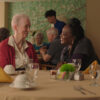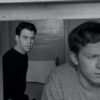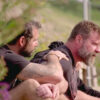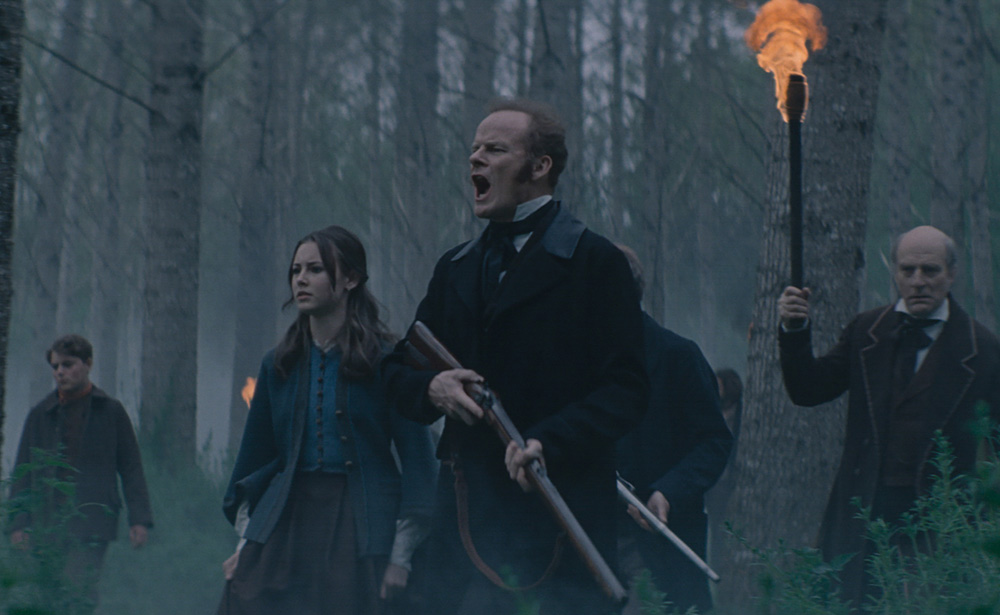There are two spells cast at the start of “The Cursed,” Sean Ellis’ ferocious new supernatural thriller, the first involving a collection of gypsies pushed off of land that they have about as much stake to as the British settlers who got there just a few decades before. As a cholera epidemic rages on elsewhere in Europe, the perceived threat of the small band of natives squatting on the palatial estate is too much for Seamus (Alistair Petrie), the head of the settlement who orders his men to get rid of them by any means necessary, with little resistance in return except for the curse of one of the gypsies’ elders. The second of the spells is what the talented Ellis casts over an audience as you start to see the curse take hold over various people on the palatial estate, alarming Seamus particularly it seems his children Charlotte and Edward or wife Isabelle (Kelly Reilly) are within its reach, making no distinctions as it brings one after another to its knees.
Ellis was originally inspired to tell a story of addiction, as the settlers will give into their worst impulses for temporary relief, but “The Cursed” arrives in the time of COVID with an especially eerie resonance when despite one major villain that has no preferences (and can only be destroyed by a silver bullet, cheekily enough), plenty of others are created as who is offered protection becomes a matter of wealth and status within the community. Naturally, science is brought in as a great equalizer in the form of John McBride (Boyd Holbrook), a pathologist who starts examining the bodies that pile up for a cause of death that may help with figuring out a way to prevent more. Thankfully, he’s pretty handy with a musket as well once the curse starts to physically manifest itself and Ellis, so gifted at blending genres since his debut sci-fi romantic comedy “Cashback,” creates a thriller where every action beat is all the more satisfying because of how it’s an extension of the well-crafted story.
Following the film’s premiere at the Sundance Film Festival where it went by the title “Eight for Silver,” the writer/director — as well as being his own cinematographer — spoke about how he set about making a new breed of monster movie with “The Cursed,” the good fortune of dividing the production into two parts and finding such an incredible central location to stage the production.
This seems like the kind of movie you spend a career waiting to make. Was the desire to do something like this kicking around in your head for a while?
A little bit. Obviously, I grew up on ‘80s horror films, so “The Thing,” “American Werewolf in London,” and Alien all had a big impression on me, and there’s been a want to try and create something within a world like that for some time. It was just the question of what was it and how do I do it? When I started speaking to Pete Shilaimon and Mickey Liddell in 2018 after we’d done “Anthropoid” together, they said, “We’d love to make like a horror film. is there something that you’d like to do in that genre?” And I just I started thinking about the werewolf. At the time, everybody was still zombie crazy and there were zombies that run, zombies that are aristocratic, or zombies that are comedic, so everybody did something in that genre, but the werewolf, looking [at something like] “The Wolf Man,” which was the last one that Universal put out, there was definitely something that I felt could be done with that story and update it somehow.
I spoke about that briefly with Mickey and Pete and they said, “Oh, we liked that. Can you write something down on a piece of paper and let’s just continue talking?” That page then turned into five and then from that, it turned into 60 or 70 pages, and when we thought we were going to be losing the winter for 2019, they said, “Listen, it’s December. We want to be shooting in the winter. We love the feeling that you have in the script, so do you think we could start filming early next year and get something in the can and maybe look to come back towards the end of the year and shoot whatever is missing?”
I really liked the idea of splitting it up and shooting [the film in] two blocks, so that’s what we did. We shot at the beginning of 2019, and then we shot again in the beginning of 2020, where we had to keep what we had and discuss further about the world and what we felt it needed and what was missing and what we liked, what we wanted to push more. You don’t get to work that way very often. The script is the script generally and you go and shoot the script, but Mickey and Pete really gave me a lot of support in having the time to develop it and that’s what it needed because a lot of time we were like we didn’t really know what it was and we didn’t know if it would work. It’s not until you actually start seeing it in the edit and you go, “Well, actually that doesn’t work, does it? So okay. What does work well?” And you start playing on the strengths. It became a very organic process really.
Something that seems really exciting was how decentralized it is – there are main characters, but when you meet McBride, the pathologist or the family, you figure you’ll be close to them for as long as their journey goes, but you really shift around. Did having that time let you figure out how to have something to hold onto while doing that?
Yeah, I felt it was always McBride’s journey, but what I hadn’t counted on for was to get as involved as you do with the other characters. Like you say, it becomes a little bit of an ensemble piece because for instance, Seamus becomes a very complex character, and I have to give credit there to Alistair Petrie because he very much brought that with him and wasn’t being black and white as far as intention goes. What he wanted was [the character] wanted to do was a bad thing, but [Alistair] wanted to make the audience feel that they would probably do it for their family if they were in the same situation, so you give him a dimension that you can empathize with [while he’s] done a pretty dastardly deed,so he becomes a very complex character.
That’s what happens when you work with great actors. They come with their own ideas and that’s what you want. You want the film and the script to just get better through these discussions and you want to discover the film as you go along. I’d hate for the film to be exactly as the script I’ve written. You want it to leap off the page and for people to breathe life into it and become something better. As captain of the ship, you try and find the best people you can and then try and get them to do their best work for you, and hopefully what’s happening is this alchemy of talent helping you bring it to fruition.
Was the film telling you what it wanted to be and was it different than your initial ideas?
Yes and no. After the first shoot, it was probably telling us more what it needed. It was obvious we’d shot the script and we all loved inhabiting this world, but we were like, “What is this?” Originally, the whole back story of the Roman clan wasn’t actually part of the first shoot, so that got written during the editing of the first section, and I liked to present those ideas to Pete and Mickey and say, “I think this is really going to expand the world and give us much more insight into who these people are and what the curse is.” Obviously one of our big things was the silver bullet, and it was fun trying to figure out why a silver bullet is a silver bullet [and what makes it special], so when that clicked, we all had this moment where we went, “Ah. This is really interesting.” We started moving stuff around, and there were a few of those a-ha click moments. The law of creation steps in at some point and helps you because it wants to be created and it’s just like you just keep pushing the ideas and they talk back to you. Some are good, some are not.
The curse is a really interesting aspect of the film because you use a variety of sensations to convey it – besides some intricate sound design, it looked like there were some specific lens choices to set the mood. What was it like to find?
Part of your preparation is testing lenses and testing candles and testing film, and what you start to see is you start to see the world slowly come alive, then once that world is alive, it generally starts to talk to you and you start to have other ideas and you go, “Hey, wouldn’t it be really good if like that happened and then we did this?” Since it was a very organic process from the start, one example of that was I remember shooting the attack of Seamus and the way that we originally shot it was so understated. The focus was purely on the candles, and you could see what was going on in the background out of focus, but afterwards, we were saying, “Why don’t we shoot a little bit more and add to that sequence.” So within that sequence, even though it’s the same scene, the shots are a year apart. It’s very interesting how malleable film is.
Was it difficult to find this location in France because it looked like you really had the run of the place?
Yeah, we did. We were quite lucky. The owners of the house only live there during the holiday, and I live in the area, so I was able to spot all these locations years before we even did the filming. When I wrote the script, I was like, “That’s going to be a great place to do this.” So in my mind as I was writing it, I really knew the locations I was going to be shooting and with the manor house, weirdly, when I first moved to the area, they approached us and said, “Would I be interested in using their house for any filming?” because they’d heard I was a film director. They had their house on some website for filming, and I don’t think they’d have much luck in getting people there, so when I went to them and said, “Hey, I’ve got this idea for a film. Could we take over the manor house for six months,” they were very excited about it and we had the run of the place for six months.
We actually did a lot of work on the place because it didn’t look that way [originally] — [we did] a lot of structural stuff like making the rooms slightly bigger or putting wood paneling on the walls, and we wallpapered and painted everything, so a lot of work went into that manor house. But we knew we were going to be stationed there for six months for the pre-production and for the shoot.
The setting is slightly vague as to where this is, though you know it’s late 1800s. Were there historical underpinnings that you were looking towards for inspiration?
There is the Bete-du-Gevaudan, which is a very famous French story about a beast that terrorized the town of Gevaudan, and it’s an actual thing, so we pinned a lot of McBride’s backstory on that and there’s been [other] films made about the beast of Gevaudan, “The Brotherhood of Wolves,” for instance. But we had fun mixing in some of the historical facts that people can actually look at online, and I think it’s always fun when you can do that. Again, like the myth of the silver bullet, it’s fun to base that on some kind of fact that we all know about, but then have that cross over into fiction.
It appeared a lot of this was done with practical effects and it must be a dream as a filmmaker to make a film like this and visit the prostethics workshop. What was like to work with?
That’s one of the real pleasures of my job in the sense that even from the first conversations that I had with Mark Coulier about what the creature design was going to be, it was very exciting. We would start to get these sketches back from him and then we had this idea of what it could be. Then Jean-Christophe Spadaccini kind of came on and sculptured the whole thing in real size. At that point when you’re in their workshops and you’re seeing what they’re doing, it is pretty phenomenal. Then those things are on set and it’s slow and it’s painful and it doesn’t always work. Sometimes the result is slightly disappointing, and even though I had this very romantic idea that I wanted to shoot everything in camera, at some point you look at it and you go animatronic puppets look like animatronic puppets. It’s just the way it is.
So we said, “Well, let’s look at enhancing what we’ve got with CG and figuring what that is.” Then the beast underwent another design change, so it became something slightly different, just by looking at what the CG guys could do, looking at what we had and then having a concept artist come on board and reshape it. So it was a lot of work and it was in constant flux until right up until literally the point [of] Sundance [where] at some point we were like, “If we’re going to be ready for Sundance, we have to approve the beast.” Not that I think it wasn’t ready, because we knew at that point what the beast was going to look like, but it was literally like, “Okay, you just got to stop work because otherwise you’re not going to be ready for Sundance.” So it was very fun, obviously working remotely with all these guys [where it was] cool to see them on these Zoom calls and then they’re showing you what they’ve done on their computer. It was a lot of fun.
“The Cursed” will open in theaters on February 18th.




